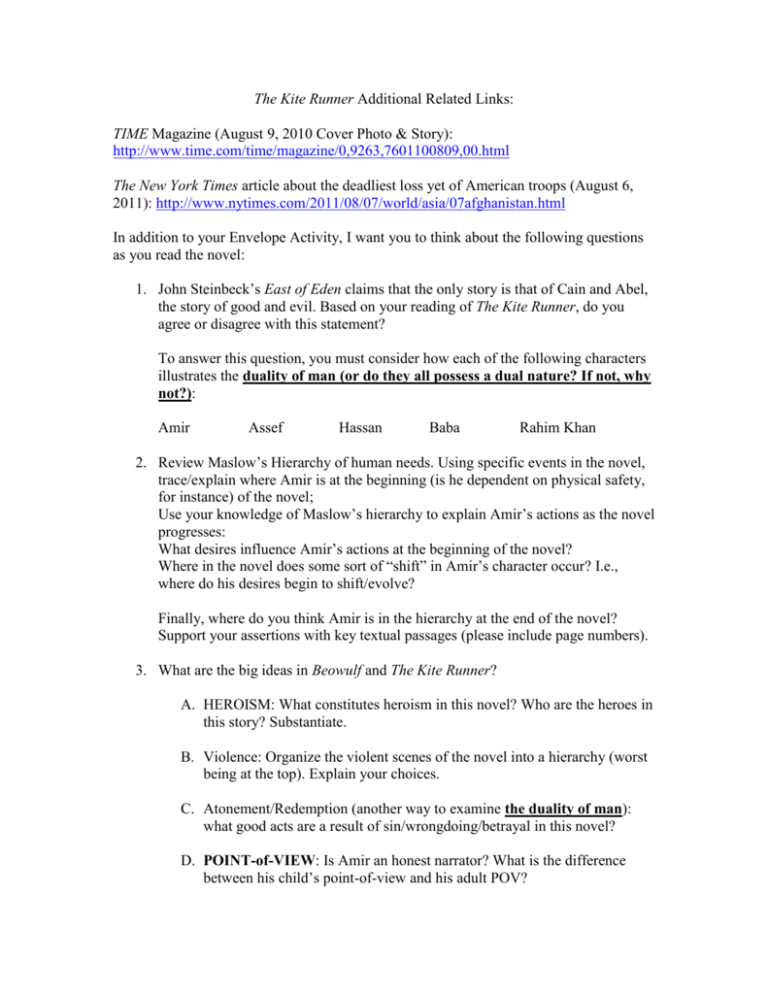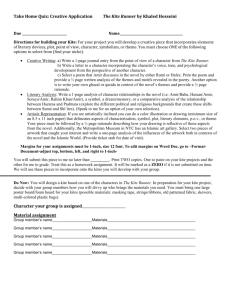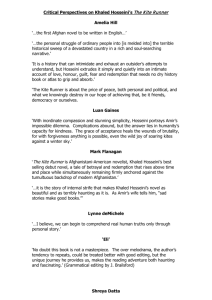Snookal 2010, from assignment by Letitia Hughes, Barren County
advertisement

The Kite Runner Additional Related Links: TIME Magazine (August 9, 2010 Cover Photo & Story): http://www.time.com/time/magazine/0,9263,7601100809,00.html The New York Times article about the deadliest loss yet of American troops (August 6, 2011): http://www.nytimes.com/2011/08/07/world/asia/07afghanistan.html In addition to your Envelope Activity, I want you to think about the following questions as you read the novel: 1. John Steinbeck’s East of Eden claims that the only story is that of Cain and Abel, the story of good and evil. Based on your reading of The Kite Runner, do you agree or disagree with this statement? To answer this question, you must consider how each of the following characters illustrates the duality of man (or do they all possess a dual nature? If not, why not?): Amir Assef Hassan Baba Rahim Khan 2. Review Maslow’s Hierarchy of human needs. Using specific events in the novel, trace/explain where Amir is at the beginning (is he dependent on physical safety, for instance) of the novel; Use your knowledge of Maslow’s hierarchy to explain Amir’s actions as the novel progresses: What desires influence Amir’s actions at the beginning of the novel? Where in the novel does some sort of “shift” in Amir’s character occur? I.e., where do his desires begin to shift/evolve? Finally, where do you think Amir is in the hierarchy at the end of the novel? Support your assertions with key textual passages (please include page numbers). 3. What are the big ideas in Beowulf and The Kite Runner? A. HEROISM: What constitutes heroism in this novel? Who are the heroes in this story? Substantiate. B. Violence: Organize the violent scenes of the novel into a hierarchy (worst being at the top). Explain your choices. C. Atonement/Redemption (another way to examine the duality of man): what good acts are a result of sin/wrongdoing/betrayal in this novel? D. POINT-of-VIEW: Is Amir an honest narrator? What is the difference between his child’s point-of-view and his adult POV? E. KINSHIP/COMITATUS vs. ALIENATION: What kinds exist in The Kite Runner? What are the categories into which people divide themselves in this novel? Who belongs, and who doesn’t? F. SETTING: What are the gathering places in this novel? G. FOILS: Official definition: A character who contrasts with the protagonist in ways that bring out certain of his or her moral, emotional, or intellectual qualities. H. Who are Amir’s foils? (Which characters are ALIKE/have traits or situations in common? How do they respond differently to their situations? Similarly?) I. SYMBOLS: What are the symbols in The Kite Runner? What abstract qualities/universal ideas do they represent? J. THEMES: What quotations in the novel illustrate “big ideas” or themes? Include page numbers.






